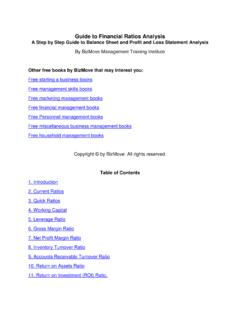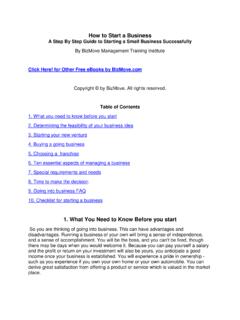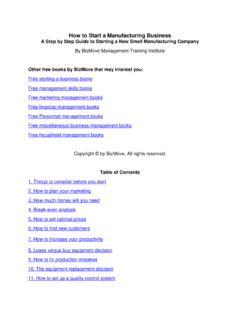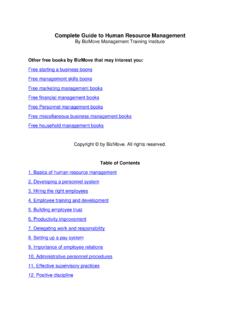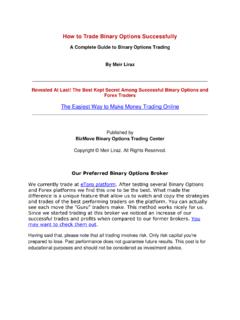Transcription of Guide to Financial Ratios Analysis A Step by Step Guide to ...
1 Guide to Financial Ratios Analysis A step by step Guide to Balance Sheet and Profit and Loss Statement Analysis By BizMove Management Training Institute Other free books by BizMove that may interest you: Free starting a business books Free management skills books Free marketing management books Free Financial management books Free Personnel management books Free miscellaneous business management books Free household management books Copyright by BizMove. All rights reserved. Table of Contents 1. Introduction 2. Current Ratios 3. Quick Ratios 4. Working Capital 5.
2 Leverage Ratio 6. Gross Margin Ratio 7. Net Profit Margin Ratio 8. Inventory Turnover Ratio 9. Accounts Receivable Turnover Ratio 10. Return on Assets Ratio 11. Return on Investment (ROI) Ratio. 12. Understanding Financial Statements: 1. Introduction If you are not fully familiar with the structure of Financial statements please read first the bonus Guide : Understanding Financial Statements. What is ratio Analysis ? The Balance Sheet and the Statement of Income are essential, but they are only the starting point for successful Financial management.
3 Apply Ratio Analysis to Financial Statements to analyze the success, failure, and progress of your business. Ratio Analysis enables the business owner/manager to spot trends in a business and to compare its performance and condition with the average performance of similar businesses in the same industry. To do this compare your Ratios with the average of businesses similar to yours and compare your own Ratios for several successive years, watching especially for any unfavorable trends that may be starting. Ratio Analysis may provide the all-important early warning indications that allow you to solve your business problems before your business is destroyed by them.
4 Go to Top Balance Sheet Ratio Analysis Important Balance Sheet Ratios measure liquidity and solvency (a business's ability to pay its bills as they come due) and leverage (the extent to which the business is dependent on creditors' funding). They include the following Ratios : Liquidity Ratios These Ratios indicate the ease of turning assets into cash. They include the Current Ratio, Quick Ratio, and Working Capital. Go to Top 2. Current Ratios The Current Ratio is one of the best known measures of Financial strength. It is figured as shown below: Current Ratio =.
5 Total Current Assets _____. Total Current Liabilities The main question this ratio addresses is: "Does your business have enough current assets to meet the payment schedule of its current debts with a margin of safety for possible losses in current assets, such as inventory shrinkage or collectable accounts?". A generally acceptable current ratio is 2 to 1. But whether or not a specific ratio is satisfactory depends on the nature of the business and the characteristics of its current assets and liabilities. The minimum acceptable current ratio is obviously 1:1, but that relationship is usually playing it too close for comfort.
6 If you decide your business's current ratio is too low, you may be able to raise it by: Paying some debts. Increasing your current assets from loans or other borrowings with a maturity of more than one year. Converting non-current assets into current assets. Increasing your current assets from new equity contributions. Putting profits back into the business. Go to Top 3. Quick Ratios The Quick Ratio is sometimes called the "acid-test" ratio and is one of the best measures of liquidity. It is figured as shown below: Quick Ratio =. Cash + Government Securities + Receivables _____.
7 Total Current Liabilities The Quick Ratio is a much more exacting measure than the Current Ratio. By excluding inventories, it concentrates on the really liquid assets, with value that is fairly certain. It helps answer the question: "If all sales revenues should disappear, could my business meet its current obligations with the readily convertible `quick' funds on hand?". An acid-test of 1:1 is considered satisfactory unless the majority of your "quick assets". are in accounts receivable, and the pattern of accounts receivable collection lags behind the schedule for paying current liabilities.
8 Go to Top 4. Working Capital Working Capital is more a measure of cash flow than a ratio. The result of this calculation must be a positive number. It is calculated as shown below: Working Capital = Total Current Assets - Total Current Liabilities Bankers look at Net Working Capital over time to determine a company's ability to weather Financial crises. Loans are often tied to minimum working capital requirements. A general observation about these three Liquidity Ratios is that the higher they are the better, especially if you are relying to any significant extent on creditor money to finance assets.
9 Go to Top 5. Leverage Ratio This Debt/Worth or Leverage Ratio indicates the extent to which the business is reliant on debt financing (creditor money versus owner's equity): Debt/Worth Ratio =. Total Liabilities _____. Net Worth Generally, the higher this ratio, the more risky a creditor will perceive its exposure in your business, making it correspondingly harder to obtain credit. Go to Top Income Statement Ratio Analysis The following important State of Income Ratios measure profitability: 6. Gross Margin Ratio This ratio is the percentage of sales dollars left after subtracting the cost of goods sold from net sales.
10 It measures the percentage of sales dollars remaining (after obtaining or manufacturing the goods sold) available to pay the overhead expenses of the company. Comparison of your business Ratios to those of similar businesses will reveal the relative strengths or weaknesses in your business. The Gross Margin Ratio is calculated as follows: Gross Margin Ratio =. Gross Profit _____. Net Sales (Gross Profit = Net Sales - Cost of Goods Sold). Go to Top 7. Net Profit Margin Ratio This ratio is the percentage of sales dollars left after subtracting the Cost of Goods sold and all expenses , except income taxes.
